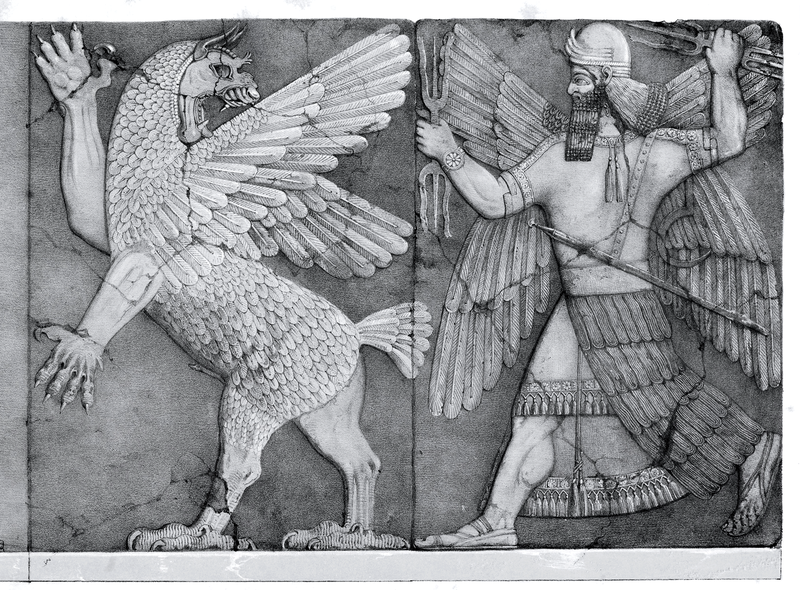Datoteka:Chaos Monster and Sun God.png

Vidi sliku u punoj veličini ((2.012 × 1.484 piksela, veličina datoteke: 3,52 MB, <a href="/wiki/MIME" title="MIME">MIME</a> tip: image/png))
| Ova je datoteka sa stranica Zajedničkog poslužitelja Zaklade Wikimedije i smiju je rabiti drugi projekti. Opis s njezine stranice s opisom datoteke prikazan je ispod. |
Sažetak
| OpisChaos Monster and Sun God.png |
English: Black and white crop of full engraving plate scan - from Plate 5 of the work "A second series of the monuments of Nineveh: including bas-reliefs from the Palace of Sennacherib and bronzes from the ruins of Nimroud ; from drawings made on the spot, during a second expedition to Assyria" (AH Layard)
The description given in the text of the work of the plate reads :
The plate description is on page 2 of the work. The image in the book is by Faucher-Gudin , an drawing based on the excavated Bas-Relief. The Bas-Relief was in not as good condition. Sources for the description an full plate include :
The reference in the text to "Ibid. p.348" is to Discoveries in the ruins of Nineveh and Babylon (Layard, 1853) - which can be seen here https://archive.org/stream/discoveriesinru00layagoog#page/n398/mode/2up quote (p.348-349):
There is also in the same work and illustration of the relief in situ in the temple (between p.350 and 351)
There are at least two interpretations of what the image is/was intended to represent.
A discussion of the development of the interpretation of this image can be found here http://oracc.museum.upenn.edu/nimrud/livesofobjects/anzu/index.html archived link
The original gypsum wall carving from which the drawing was taken is now (2018) displayed in Room 6 of the British Museum. Details of the object can be found here:
The actual object also has a cuneiform inscription across the (approx.) middle third, not reproduced in the drawing. The texts is thought to be a "boilerplate" text used throughout the palace/temple on several reliefs - for more details and translation of a presumed nearly identical text see Assyrian Rulers of the Early First Millennium BC, I (1114-859 BC) vol. 1, (Grayson, Albert Kirk,Toronto, University of Toronto Press, 1991) p.232 no.5 (entry A.0.101.5) which references entry A.0.101.3 ; there were also inscriptions on the backs of the slabs - see same publication reference A.0.101.31 (no.31, p.293) .. the inscriptions reference Ashurnasirpal [II] son of Tukulti-Ninurta [II] - which dates the objects to 883 to 859 BC. (see en:Ashurnasirpal II) Note that the object was one of a pair on either side of the passage - [based on the drawing by Malan] the object's pair was left-right inverted so that the portrayals matched - a drawing of the object's pair by S.C. Malan partially in-situ at the excavation can be found in A Visiting Artist at Nineveh in 1850 (C. J. Gadd) in the journal "Iraq" vol.5, 1938 , DOI: 10.2307/4241628 , [1] , description p.120 no. 134, illus. plate XV |
| Datum | |
| Izvor | 'Monuments of Nineveh, Second Series' plate 5, London, J. Murray, 1853 |
| Autor | editor Austen Henry Layard , drawing by L. Gruner |
Licencija
| Public domainPublic domainfalsefalse |
|
Ovo je djelo u javnom vlasništvu u zemlji podrijetla i u drugim zemljama s rokom trajanja autorskih prava za života autora plus 100 godina ili manje. Ovo je djelo u javnom vlasništvu u SAD-u zato jer je objavljeno (ili registrirano pri Uredu za autorska prava Sjedinjenih Američkih Država) prije 1. siječnja 1929. | |
| Ova datoteka je identificirana kao slobodna od poznatih ograničenja po zakonu o autorskim pravima, uključujući sva povezana i srodna prava. | |
https://creativecommons.org/publicdomain/mark/1.0/PDMCreative Commons Public Domain Mark 1.0falsefalse
Opisi
1853
image/png
checksum engleski
5e4d2a68abfe86ec30cd6d314e83108d2a396fcc
data size engleski
3.686.873 Bajt
1.484 točka
2.012 točka
Povijest datoteke
Kliknite na datum/vrijeme kako biste vidjeli datoteku kakva je tada bila.
| Datum/Vrijeme | Minijatura | Dimenzije | Suradnik | Komentar | |
|---|---|---|---|---|---|
| sadašnja | 14:45, 21. svibnja 2016. |  | 2.012 × 1.484 (3,52 MB) | Vles1 | I increased the contrast of the picture. |
Poveznice
Na ovu sliku vode poveznice sa sljedećih stranica:
Metapodatci
Ova datoteka sadržava dodatne podatke koje je vjerojatno dodala digitalna kamera ili skener u procesu snimanja odnosno digitalizacije. Ako je datoteka mijenjana, podatci možda nisu u skladu sa stvarnim stanjem.
| Vodoravna razlučivost | 28,34 dpc |
|---|---|
| Okomita razlučivost | 28,34 dpc |